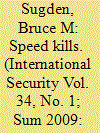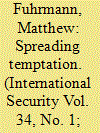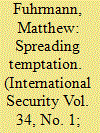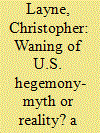|
|
|
Sort Order |
|
|
|
Items / Page
|
|
|
|
|
|
|
| Srl | Item |
| 1 |
ID:
090986


|
|
|
|
|
| Publication |
2009.
|
| Summary/Abstract |
Bargaining models of war suggest that war ends after two sides develop an overlapping bargaining space. Domestic mechanisms-domestic governing coalitions, a state's elite foreign policy decisionmaking group, and their role in ending interstate war-are critical in explaining how, when, and why that bargaining space develops. Through preference, information, and entrapment obstacles, wars can become "stuck" and require a change in expectations to produce a war-terminating bargaining space. A major source of such change is a shift in belligerents' governing coalitions. Events in the United States, China, and the Soviet Union during the Korean War illustrate the dynamics of these obstacles and the need for domestic coalition shifts in overcoming them before the conflict could be brought to an end.
|
|
|
|
|
|
|
|
|
|
|
|
|
|
|
|
| 2 |
ID:
091419


|
|
|
|
|
| Publication |
2009.
|
| Summary/Abstract |
Bargaining models of war suggest that war ends after two sides develop an overlapping bargaining space. Domestic mechanisms-domestic governing coalitions, a state's elite foreign policy decisionmaking group, and their role in ending interstate war-are critical in explaining how, when, and why that bargaining space develops. Through preference, information, and entrapment obstacles, wars can become "stuck" and require a change in expectations to produce a war-terminating bargaining space. A major source of such change is a shift in belligerents' governing coalitions. Events in the United States, China, and the Soviet Union during the Korean War illustrate the dynamics of these obstacles and the need for domestic coalition shifts in overcoming them before the conflict could be brought to an end.
|
|
|
|
|
|
|
|
|
|
|
|
|
|
|
|
| 3 |
ID:
091420


|
|
|
|
|
| Publication |
2009.
|
| Summary/Abstract |
Many studies of the 1999 Kosovo crisis argue that although airpower played an important role in forcing President Slobodan Miloševi?'s capitulation, NATO's threat of a ground invasion was critical. Other studies claim that no such threat existed or that it was irrelevant to ending the crisis. Instead, they attribute NATO's success solely to the strategic use of coercive airpower. There is, however, another explanation: the rising dissatisfaction with Miloševi?'s rule among his supporters as the crisis dragged on. Despite NATO's overwhelming strategic superiority, Miloševi? was able to reject his adversary's terms of surrender until his political position became untenable. This suggests that airpower may have greater limitations as a tool of statecraft than its supporters maintain.
|
|
|
|
|
|
|
|
|
|
|
|
|
|
|
|
| 4 |
ID:
091421


|
|
|
|
|
| Publication |
2009.
|
| Summary/Abstract |
Should the United States deploy conventional ballistic missiles (CBMs) in support of the prompt global strike (PGS) mission? Most important, do the political-military benefits outweigh the risks of CBM deployment? The United States, if it works to mitigate the risk of misperception and an inadvertent nuclear response, should deploy near-term CBMs in support of the PGS mission. The prompt response of CBMs would likely be sufficient to defeat many time-sensitive, soft targets, provided actionable intelligence was available. Near-term CBMs, those options capable of being deployed prior to 2013, would have the required attributes to defeat their targets: payload flexibility, throw weight, and accuracy.
|
|
|
|
|
|
|
|
|
|
|
|
|
|
|
|
| 5 |
ID:
090994


|
|
|
|
|
| Publication |
2009.
|
| Summary/Abstract |
Should the United States deploy conventional ballistic missiles (CBMs) in support of the prompt global strike (PGS) mission? Most important, do the political-military benefits outweigh the risks of CBM deployment? The United States, if it works to mitigate the risk of misperception and an inadvertent nuclear response, should deploy near-term CBMs in support of the PGS mission. The prompt response of CBMs would likely be sufficient to defeat many time-sensitive, soft targets, provided actionable intelligence was available. Near-term CBMs, those options capable of being deployed prior to 2013, would have the required attributes to defeat their targets: payload flexibility, throw weight, and accuracy. More specifically, the U.S. Navy's Conventional Trident Modification is a cost-effective, near-term PGS option that would mitigate the concerns of CBM opponents. The large-scale use of midterm and long-term CBMs against mobile targets and hard and deeply buried targets, however, will require a wider range of technologies that have yet to mature. Thus, the United States should continue investing in research and development for a broad portfolio of PGS options to cover the emerging target set.
|
|
|
|
|
|
|
|
|
|
|
|
|
|
|
|
| 6 |
ID:
090985


|
|
|
|
|
| Publication |
2009.
|
| Summary/Abstract |
Peaceful nuclear cooperation-the transfer of nuclear technology, materials, or know-how from one state to another for peaceful purposes-leads to the spread of nuclear weapons. In particular, countries that receive peaceful nuclear assistance are more likely to initiate weapons programs and successfully develop the bomb, especially when they are also faced with security threats. Statistical analysis based on a new data set of more than 2,000 bilateral civilian nuclear cooperation agreements signed from 1950 to 2000 lends strong support for this argument. Brief case studies of the Indian and Pakistani nuclear weapons programs provide further evidence of the links between peaceful nuclear assistance and proliferation. The finding that supplier countries inadvertently raise the risks of nuclear proliferation poses challenges to the conventional wisdom. Indeed, the relationship between civilian nuclear cooperation and proliferation is surprisingly broad. Even assistance that is often viewed as innocuous, such as training nuclear scientists or providing research or power reactors, increases the likelihood that nuclear weapons will spread. "Proliferation-proof" nuclear assistance does not exist. With a renaissance in nuclear power on the horizon, major suppliers, including the United States, should reconsider their willingness to assist other countries in developing peaceful nuclear programs.
|
|
|
|
|
|
|
|
|
|
|
|
|
|
|
|
| 7 |
ID:
091418


|
|
|
|
|
| Publication |
2009.
|
| Summary/Abstract |
Peaceful nuclear cooperation-the transfer of nuclear technology, materials, or know-how from one state to another for peaceful purposes-leads to the spread of nuclear weapons. In particular, countries that receive peaceful nuclear assistance are more likely to initiate weapons programs and successfully develop the bomb, especially when they are also faced with security threats. Statistical analysis based on a new data set of more than 2,000 bilateral civilian nuclear cooperation agreements signed from 1950 to 2000 lends strong support for this argument. Brief case studies of the Indian and Pakistani nuclear weapons programs provide further evidence of the links between peaceful nuclear assistance and proliferation.
|
|
|
|
|
|
|
|
|
|
|
|
|
|
|
|
| 8 |
ID:
090996


|
|
|
|
|
| Publication |
2009.
|
| Summary/Abstract |
Over the next two decades, international politics will be shaped by whether the international system remains unipolar or is transformed into a multipolar system. Can the United States sustain its primacy? Or will the emergence of new great powers reorder the distribution of power in the international system? If U.S. power is waning, will power transition dynamics result in security competitions and an increased possibility of war? In particular, what are the implications of China's rapid ascent to great power status? If the United States is unable to preserve its hegemonic role, what will happen to the security and economic frameworks that it took the lead in creating after the end of World War II and that have provided the foundation for the international order ever since? In a world no longer defined by U.S. hegemony, what would become of globalization and the open international economic system that the United established after World War II and expanded after the Cold War ended? This essay reviews five publications that grapple with these questions: Stephen G. Brooks and William C. Wohlforth, World Out of Balance: International Relations and the Challenge of American Primacy; Parag Khanna, The Second World: Empires and Influence in the New Global Order; Kishore Mahbubani, The New Asian Hemisphere: The Irresistible Shift of Global Power to the East; National Intelligence Council, Global Trends 2025: A Transformed World; and Fareed Zakaria, The Post-American World.
|
|
|
|
|
|
|
|
|
|
|
|
|
|
|
|
|
|
|
|
|